
Healthy Fats You Should Be Enjoying
Walnuts
Walnuts have earned their superfood status in part because of their fats. They are one of the few foods to deliver alpha-linolenic acid (ALA), a type of omega-3 fat thought to protect against heart disease. Toast them to bring out their flavor and extra crunch, then sprinkle about a tablespoon on yogurt or fold some into muffins or your morning oatmeal.
Olives
Olive oil is a great way to get monounsaturated fats in your diet, but so are olives. They also deliver plant sterols — compounds that can lower "bad" LDL cholesterol. Olives can be pretty high in sodium, but you can take away some of that salt by soaking them in fresh water.
Avocados
Avocados get their creamy texture from heart-healthy monounsaturated fats. They also deliver fiber, which helps you feel full, as well as potassium and vitamin C. For a heart-smart and delicious breakfast, smash an avocado onto gluten free toast.
Virgin Coconut Oil
Coconut oil is an excellent rich source of Medium-Chain Triglycerides (MCT’s), a type of saturated fat. The fats in coconut oil are 65% MCT. Some evidence shows that consuming MCT’s may increase the number of calories your body burns, just be careful to use it sparingly with no more than a Tablespoon a day. MCT’s in Coconut Oil provide a quick supply of energy also, as fat molecules are transported through your blood to tissues that need them, such as your brain, fat tissue and muscle that need them. MCT’s also go straight to your liver and become a rapid energy supply in much the same way as carbohydrates do, your body’s preferred source of energy.
Coconut oil is particularly good for cooking at high temperatures, since it has a higher smoke point than olive oil.
Valencia Organic Peanut Butter
Smear some Gluten Free toast or apple slices with Organic Peanut Butter from Valencia which doesn’t have mold, and you have a breakfast or snack with staying power. The unsaturated fats in peanut butter help make the meal satisfying by making it take longer to digest, and it’s also packed with protein. Stick to natural peanut butter to avoid the added sugars and unhealthy partially hydrogenated fats that are added to other kinds of peanut butter. Read the label, it should only have peanuts.
Salmon
As an "oily" fish, salmon has lots of DHA and EPA — two kinds of omega-3 fats that can reduce inflammation, lowering risk of skin cancer and heart disease. Want an alternative to salmon? Trout, mackerel, sardines and herring are all good choices for getting DHA and EPA into your diet.
Flaxseed
Flaxseed is high in a plant-based form of omega-3 fatty acids: alpha-linolenic acid (ALA). ALA is linked to heart health by improving blood pressure. Grind up 2 tablespoons or so in a clean coffee grinder and sprinkle it over cereal or yogurt.
Almonds
Almonds are particularly high in monounsaturated fat, the kind that helps improve your cholesterol levels. They’re a smart choice for snacking; in addition to those healthy fats, almonds provide fiber and protein, which help keep you feeling satisfied. About a dozen is an appropriate serving.
Stay healthy my friends! Enjoy!
 Add Row
Add Row  Add
Add 










Write A Comment